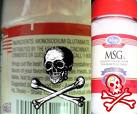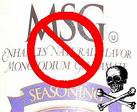(Courtesy: Mercola.com)

We got a LOT of mail asking us about MSG. We’ve written about it before, but because of a recent influx of new email on the topic, we thought we’d treat the subject again. Like a bad penny, MSG and its problems just won’t go away!
MSG (monosodium glutamate), is a flavor enhancer that’s known widely as an addition to Chinese food, but it’s actually added to thousands of foods we all regularly eat—especially processed foods.

It’s one of the worst food additives on the market and is used in canned soups, crackers, meats, salad dressings, frozen dinners and much more. It’s found in our local supermarkets and restaurants, in our children’s school cafeterias and, amazingly, even in baby food and infant formula!
MSG is more than just a seasoning like salt and pepper, it actually enhances the flavor of foods, making processed meats and frozen dinners taste fresher and smell better, salad dressings more tasty, and canned foods less tinny. But while MSG’s benefits to the food industry are quite clear, this additive is slowly and silently doing major damage to our health.
What Exactly is MSG?

Remember when the MSG powder called “Accent” first hit the U.S. market? It had been around long before that. It was in 1908, that monosodium glutamate was invented. The inventor was Kikunae Ikeda, a Japanese man who identified the natural flavor enhancing substance of seaweed.

Taking a hint from this substance, he was created the man-made additive MSG, and he and a partner went on to form Ajinomoto, which is now the world’s largest producer of MSG (and interestingly also a drug manufacturer).
Chemically speaking, it is approximately 78% free glutamic acid, 21% sodium, and up to 1% contaminants. It’s a misconception that MSG is a flavor or “meat tenderizer.” In reality, it has very little taste at all, yet when you eat MSG, you think the food you’re eating has more protein and tastes better. It does this by tricking your tongue, using a little-known fifth basic taste: umami.
Umami is the taste of glutamate, which is a savory flavor found in many Japanese foods, bacon and also in the toxic food additive MSG. It is because of umami that foods with MSG taste heartier, more robust and generally better than foods without it.
The ingredient didn’t become widespread in the United States until after World War II, when the U.S. military realized Japanese rations were much tastier than the U.S. versions, because of MSG.

In 1959, the U.S. Food and Drug Administration labeled MSG as “Generally Recognized as Safe” (GRAS), and it has remained that way ever since. Yet, it was a telling sign when just 10 years later a condition known as “Chinese Restaurant Syndrome” entered the medical literature, describing numerous side effects—numbness to heart palpitations—that people experienced after eating MSG.
Today that syndrome is more appropriately called “MSG Symptom Complex,” which the Food and Drug Administration (FDA) identifies as "short-term reactions" to MSG.
So if the reactions are “short term”, why is MSG so Dangerous?

Board-certified neurosurgeon and author of “Excitotoxins: The Taste that Kills,” Dr. Russell Blaylock, says that the very real danger of MSG is because it is an excitotoxin—it overexcites cells to the point of damage or death, causing brain damage to varying degrees -- and potentially even triggering or worsening learning disabilities, Alzheimer’s disease, Parkinson’s disease, Lou Gehrig’s disease and more.
Part of the problem also is that free glutamic acid is the same neurotransmitter that the brain, nervous system, eyes, pancreas and other organs use to initiate certain processes in the body.

Although the FDA continues to claim that MSG does not cause these ill effects, many other experts say otherwise. And according to Dr. Blaylock, numerous glutamate receptors have been found both within the heart's electrical conduction system and the heart muscle itself. This can damage the heart, and even explains the sudden deaths sometimes seen among young athletes.
Many other adverse effects have also been linked to regular consumption of MSG, including:obesity, eye damage, headaches, fatigue and disorientation, and depression. And even the FDA admits that “short-term reactions” known as MSG Symptom Complex can occur in certain groups of people, namely those who have eaten “large doses” of MSG or those who have asthma. MSG Symptom Complex involves symptoms such as numbness, burning sensation, tingling in extremities, facial pressure or tightness, chest pain/difficulty breathing, headache, nausea, rapid heartbeat, drowsiness, and weakness.
Use of MSG is expanding dramatically and it’s estimated that up to 40% of the population may be impacted.
So how do we know if MSG is in our food?

Food manufacturers arn’t stupid—they know people want to avoid eating this junk. As a result, most of them have just tried to “clean” their labels—they’ve tried to hide the fact that MSG is an ingredient. How do they do this? By using names that you would never associate with MSG.
You see, it’s required by the FDA that food manufacturers list the ingredient “monosodium glutamate” on food labels, but they don’t have to label ingredients that contain free glutamic acid, even though it’s the main component of MSG.

There are over 40 labeled ingredients that contain glutamic acid, but you’d never know it just from their names alone. Further, in some foods glutamic acid is formed during processing and, again, food labels give you no way of knowing for sure.
So here’s how to keep MSG out of your diet:
In general, if a food is processed you can assume it contains MSG (or one of its pseudo-ingredients). So sticking to a whole, fresh foods diet can pretty much guarantee that you’ll avoid this toxin.

The other place where you’ll need to watch out for MSG is in restaurants. Ask your server which menu items are MSG-free, and request that no MSG be added to your meal. But of course, the only place where you can be entirely sure of what’s added to your food is in your own kitchen.
Thus, to be on the safe side, know what ingredients to watch out for on packaged foods.
Here are ingredients that ALWAYS contain MSG:
|
Autolyzed
Yeast
|
Calcium
Caseinate
|
Gelatin
|
|
Glutamate
|
Glutamic Acid
|
Hydrolyzed Protein
|
|
Monopotassium
Glutamate
|
Monosodium Glutamate
|
Sodium
Caseinate
|
|
Textured
Protein
|
Yeast Extract
|
Yeast
Food
|
|
Yeast
Nutrient
|
|
|
And these ingredients OFTEN contain MSG or create MSG during processing:
|
Flavors
and Flavorings
|
Seasonings
|
Natural
Flavors and Flavorings
|
Natural Pork
Flavoring
|
|
|
Natural
Chicken Flavoring
|
Soy
Sauce
|
Soy Protein
Isolate
|
Soy
Protein
|
|
|
Stock
|
Broth
|
Malt
Extract
|
Malt
Flavoring
|
|
|
Anything
Enzyme Modified
|
Carrageenan
|
Maltodextrin
|
Pectin
|
|
|
Protease
|
Corn
Starch
|
Citric
Acid
|
Powdered
Milk
|
|
|
|
Anything Ultra-Pasteurized
|
|
|
|


 Let’s choose to be MSG-Free!
Let’s choose to be MSG-Free!


 We got a LOT of mail asking us about MSG. We’ve written about it before, but because of a recent influx of new email on the topic, we thought we’d treat the subject again. Like a bad penny, MSG and its problems just won’t go away!
We got a LOT of mail asking us about MSG. We’ve written about it before, but because of a recent influx of new email on the topic, we thought we’d treat the subject again. Like a bad penny, MSG and its problems just won’t go away!
 It’s one of the worst food additives on the market and is used in canned soups, crackers, meats, salad dressings, frozen dinners and much more. It’s found in our local supermarkets and restaurants, in our children’s school cafeterias and, amazingly, even in baby food and infant formula!
It’s one of the worst food additives on the market and is used in canned soups, crackers, meats, salad dressings, frozen dinners and much more. It’s found in our local supermarkets and restaurants, in our children’s school cafeterias and, amazingly, even in baby food and infant formula!
 Remember when the MSG powder called “Accent” first hit the U.S. market? It had been around long before that. It was in 1908, that monosodium glutamate was invented. The inventor was Kikunae Ikeda, a Japanese man who identified the natural flavor enhancing substance of seaweed.
Remember when the MSG powder called “Accent” first hit the U.S. market? It had been around long before that. It was in 1908, that monosodium glutamate was invented. The inventor was Kikunae Ikeda, a Japanese man who identified the natural flavor enhancing substance of seaweed.
 Taking a hint from this substance, he was created the man-made additive MSG, and he and a partner went on to form Ajinomoto, which is now the world’s largest producer of MSG (and interestingly also a drug manufacturer).
Taking a hint from this substance, he was created the man-made additive MSG, and he and a partner went on to form Ajinomoto, which is now the world’s largest producer of MSG (and interestingly also a drug manufacturer).
 In 1959, the U.S. Food and Drug Administration labeled MSG as “Generally Recognized as Safe” (GRAS), and it has remained that way ever since. Yet, it was a telling sign when just 10 years later a condition known as “Chinese Restaurant Syndrome” entered the medical literature, describing numerous side effects—numbness to heart palpitations—that people experienced after eating MSG.
In 1959, the U.S. Food and Drug Administration labeled MSG as “Generally Recognized as Safe” (GRAS), and it has remained that way ever since. Yet, it was a telling sign when just 10 years later a condition known as “Chinese Restaurant Syndrome” entered the medical literature, describing numerous side effects—numbness to heart palpitations—that people experienced after eating MSG.
 Board-certified neurosurgeon and author of “Excitotoxins: The Taste that Kills,” Dr. Russell Blaylock, says that the very real danger of MSG is because it is an excitotoxin—it overexcites cells to the point of damage or death, causing brain damage to varying degrees -- and potentially even triggering or worsening learning disabilities, Alzheimer’s disease, Parkinson’s disease, Lou Gehrig’s disease and more.
Board-certified neurosurgeon and author of “Excitotoxins: The Taste that Kills,” Dr. Russell Blaylock, says that the very real danger of MSG is because it is an excitotoxin—it overexcites cells to the point of damage or death, causing brain damage to varying degrees -- and potentially even triggering or worsening learning disabilities, Alzheimer’s disease, Parkinson’s disease, Lou Gehrig’s disease and more.
 Although the FDA continues to claim that MSG does not cause these ill effects, many other experts say otherwise. And according to Dr. Blaylock, numerous glutamate receptors have been found both within the heart's electrical conduction system and the heart muscle itself. This can damage the heart, and even explains the sudden deaths sometimes seen among young athletes.
Although the FDA continues to claim that MSG does not cause these ill effects, many other experts say otherwise. And according to Dr. Blaylock, numerous glutamate receptors have been found both within the heart's electrical conduction system and the heart muscle itself. This can damage the heart, and even explains the sudden deaths sometimes seen among young athletes.
 Food manufacturers arn’t stupid—they know people want to avoid eating this junk. As a result, most of them have just tried to “clean” their labels—they’ve tried to hide the fact that MSG is an ingredient. How do they do this? By using names that you would never associate with MSG.
Food manufacturers arn’t stupid—they know people want to avoid eating this junk. As a result, most of them have just tried to “clean” their labels—they’ve tried to hide the fact that MSG is an ingredient. How do they do this? By using names that you would never associate with MSG.
 There are over 40 labeled ingredients that contain glutamic acid, but you’d never know it just from their names alone. Further, in some foods glutamic acid is formed during processing and, again, food labels give you no way of knowing for sure.
There are over 40 labeled ingredients that contain glutamic acid, but you’d never know it just from their names alone. Further, in some foods glutamic acid is formed during processing and, again, food labels give you no way of knowing for sure.
 The other place where you’ll need to watch out for MSG is in restaurants. Ask your server which menu items are MSG-free, and request that no MSG be added to your meal. But of course, the only place where you can be entirely sure of what’s added to your food is in your own kitchen.
The other place where you’ll need to watch out for MSG is in restaurants. Ask your server which menu items are MSG-free, and request that no MSG be added to your meal. But of course, the only place where you can be entirely sure of what’s added to your food is in your own kitchen.